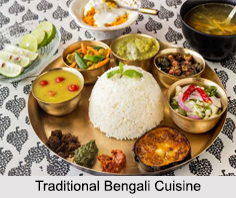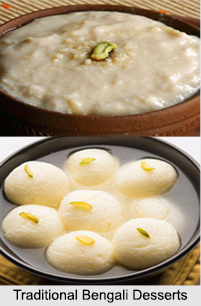 Traditional Bengali Cuisine that originated and evolved in the region of West Bengal situated in the eastern part of India is rich and varied in its platter starting from snacks to main courses to sweets. Although the food habits, tastes, preferences and choice of items vary with different districts, communities and religions, the basic course generally remains the same with rice and fish playing a dominant role. The nature of dishes found in Bengali cooking is unique. Ordinary food served at home is different from that served during social functions. Mustard oil is also an important ingredient across Bengal, as it adds a pungent flavour to dishes which is specific to these parts. Fish cuisine is one of its prominent features that distinguish it from the cooking of the non-coastal regions. Vegetables are also cooked in a very unique style by the Bengalis. Ambrosial dishes are made out of rejected peels, stalks and leaves of vegetables. Fuel-efficient methods such as steaming fish or vegetables are employed.
Traditional Bengali Cuisine that originated and evolved in the region of West Bengal situated in the eastern part of India is rich and varied in its platter starting from snacks to main courses to sweets. Although the food habits, tastes, preferences and choice of items vary with different districts, communities and religions, the basic course generally remains the same with rice and fish playing a dominant role. The nature of dishes found in Bengali cooking is unique. Ordinary food served at home is different from that served during social functions. Mustard oil is also an important ingredient across Bengal, as it adds a pungent flavour to dishes which is specific to these parts. Fish cuisine is one of its prominent features that distinguish it from the cooking of the non-coastal regions. Vegetables are also cooked in a very unique style by the Bengalis. Ambrosial dishes are made out of rejected peels, stalks and leaves of vegetables. Fuel-efficient methods such as steaming fish or vegetables are employed.
Spices in Traditional Bengali Cuisine
Traditional Bengali Cuisine is vast and elaborate and it has been special due to the various uses of sweet and spicy flavours. The use of spices for both non-vegetarian and vegetarian dishes is quite widespread and includes combinations which are not found in other parts of India. A variety of spices and their mixes are used in preparing Bengali cuisine, the common ones being halud (turmeric), jira (cumin), dhone (coriander) radhuni (wild celery seeds), kalo jira (black onion seeds), dried red chilli, bay leaves, shorshe (mustard), posto (poppy seed), methi (fenugreek), mouri (fennel), peyaj (onion), ada (ginger), narikel (ripe coconut) and a combination of five spices called "Panch Phoron" which comprise of kalo jeera, cumin, black mustard seeds, fenugreek and fennel. The use of freshly-ground mustard paste is again one of the common ingredients of Bengali dishes. Mustard paste known as "Kasundi" in Bengali language is an accompanying dipping sauce which is very common in Bengal.
 Meal in Traditional Bengali Cuisine
Meal in Traditional Bengali Cuisine
A Bengali meal follows a multi-course tradition where food is served course-wise usually in a specific format, marking it as the only meal of the subcontinent to have evolved such convention. Generally a typical traditional Bengali meal comprises of plain white rice, pinch of salt, ghee, gondhoraj lebu or the Bengali lime, daal, bhaja, vegetable, fish, mutton/ chicken, chutney and lastly dessert.
Rice is the main accompaniment to all the side dishes. Firstly, the rice is consumed with daal accompanied either with the lime or ghee as per choice. The daal can be of various types like Masoor Daal and Bhaja Moonger Daal/ Fried Moong Daal. Many also prefer to eat rice with starter and daal by squeezing a bit of the lemon in it. The list of starter is also lengthy under which comes Potato fries, potol fries, pumpkin fries, brinjal fries, bitter-gourd fries, etc. Then comes vegetable dishes like aloor dom, shukto, panchmishali charchari, etc. The fish is also prepared in different ways like it can be made in fried curry form. The curry form is named as fish curry. After fish, the rice is finally consumed with mutton or chicken. And lastly dessert is consumed. Dessert mainly comprises of Mishti Doi and Roshogolla. Roshogolla is the integral part of traditional Bengali cuisine.




















